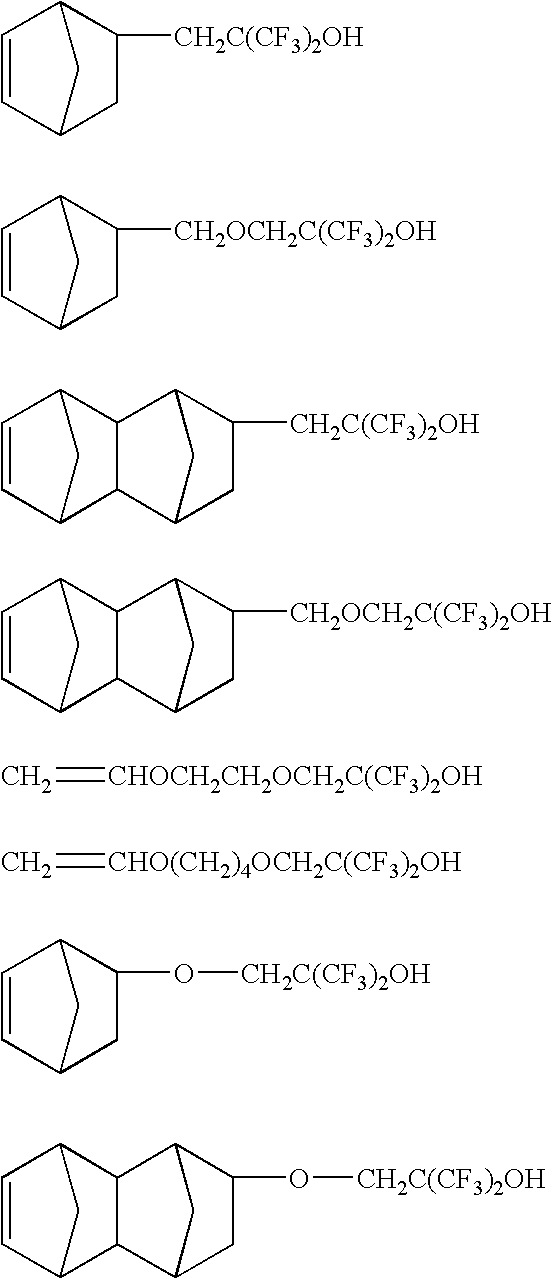Fluorinated polymers, photoresists and processes for microlithography
a technology of fluorinated alcohol and microlithography, applied in the field of copolymers, can solve the problems of not teaching the use of fluorinated alcohol comonomers in photosensitive layers (e.g., resists)
- Summary
- Abstract
- Description
- Claims
- Application Information
AI Technical Summary
Benefits of technology
Problems solved by technology
Method used
Image
Examples
example 1
Synthesis of NB—F—OH
[0155] A dry round bottom flask equipped with mechanical stirrer, addition funnel and nitrogen inlet was swept with nitrogen and charged with 19.7 g (0.78 mol) of 95% sodium hydride and 500 mL of anhydrous DMF. The stirred mixture was cooled to 5° C. and 80.1 g (0.728 mol) of exo-5-norbornen-2-ol was added dropwise so that the temperature remained below 15° C. The resulting mixture was stirred for 0.5 hr. HFIBO (131 g, 0.728 mol) was added dropwise at room temperature. The resulting mixture was stirred overnight at room temperature. Methanol (40 mL) was added and most of the DMF was removed on a rotary evaporator under reduced pressure. The residue was treated with 200 mL water and glacial acetic acid was added until the pH was about 8.0. The aqueous mixture was extracted with 3×150 mL ether. The combined ether extracts were washed with 3×150 mL water and 150 mL brine, dried over anhydrous sodium sulfate and concentrated on a rotary evaporator to an oil. Kugelro...
example 2
Copolymer of TFE, NB—F—OH and HAdA
[0157] A metal pressure vessel of approximate 270 mL capacity was charged with 82.65 g NB—F—OH, 3.33 g HAdA and 25 mL Solkane 365.
[0158] The vessel was closed, cooled to about −15° C. and pressured to 400 psi with nitrogen and vented several times. The reactor contents were heated to 50° C. TFE was added to a pressure of 270 psi and a pressure regulator was set to maintain the pressure at 270 psi throughout the polymerization by adding TFE as required. A solution of 84.58 g of NB—F—OH and 27.75 g HAdA diluted to 100 mL with Solkane 365 mfc was pumped into the reactor at a rate of 0.10 mL / minute for 12 hr. Simultaneously with the monomer feed solution, a solution of 9.6 g Perkadox® 16N and 70 mL methyl acetate diluted to 100 mL with Solkane 365 mfc was pumped into the reactor at a rate of 2.0 mL / minute for 6 minutes, and then at a rate of 0.1 mL / minute for 8 hours. After 16 hours reaction time, the vessel was cooled to room temperature and vented t...
example 3
Copolymer of TFE, NB—F—OH and TBHMA
[0159] A metal pressure vessel of approximate 270 mL capacity was charged with 71.05 g NB—F—OH, 0.79 g TBHMA and 25 mL Solkane 365. The vessel was closed, cooled to about −15° C. and pressured to 400 psi with nitrogen and vented several times. The reactor contents were heated to 50° C. TFE was added to a pressure of 340 psi and a pressure regulator was set to maintain the pressure at 340 psi throughout the polymerization by adding TFE as required. A solution of 82.57 g of NB—F—OH and 9.88 g TBHMA diluted to 100 mL with Solkane 365 mfc was pumped into the reactor at a rate of 0.10 mL / minute for 12 hr. Simultaneously with the monomer feed solution, a solution of 7.3 g Perkadox® 16N and 60 mL methyl acetate diluted to 100 mL with Solkane 365 mfc was pumped into the reactor at a rate of 2.0 mL / minute for 6 minutes, and then at a rate of 0.1 mL / minute for 8 hours. After 16 hours reaction time, the vessel was cooled to room temperature and vented to 1 a...
PUM
| Property | Measurement | Unit |
|---|---|---|
| wavelengths | aaaaa | aaaaa |
| wavelengths | aaaaa | aaaaa |
| pressure | aaaaa | aaaaa |
Abstract
Description
Claims
Application Information
 Login to View More
Login to View More - R&D
- Intellectual Property
- Life Sciences
- Materials
- Tech Scout
- Unparalleled Data Quality
- Higher Quality Content
- 60% Fewer Hallucinations
Browse by: Latest US Patents, China's latest patents, Technical Efficacy Thesaurus, Application Domain, Technology Topic, Popular Technical Reports.
© 2025 PatSnap. All rights reserved.Legal|Privacy policy|Modern Slavery Act Transparency Statement|Sitemap|About US| Contact US: help@patsnap.com



